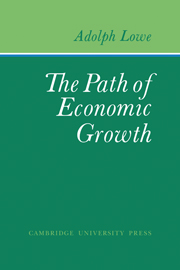Book contents
- Frontmatter
- Contents
- Preface
- Acknowledgments
- PART I The Basic Model
- 1 Introduction: Scope and Method
- 2 Patterns of Economic Growth
- 3 A Schema of Industrial Production
- 4 The Circulation of Fixed Capital
- 5 The Circulation of Working Capital
- 6 The Stationary Process in Operation: Structure Analysis
- 7 The Stationary Process in Operation: Force Analysis
- 8 Transition to Dynamic Equilibrium
- 9 Dynamic Equilibrium: Structure Analysis
- 10 Dynamic Equilibrium: Force Analysis
- PART II Changes in the Rate of Change
- PART III Changes in the Rate of Change
- PART IV Changes in the Rate of Change
- Appendix: An Alternative Presentation of Lowe's Basic Model
- Glossary of Recurring Symbols
- Name Index
- Subject Index
1 - Introduction: Scope and Method
Published online by Cambridge University Press: 07 October 2011
- Frontmatter
- Contents
- Preface
- Acknowledgments
- PART I The Basic Model
- 1 Introduction: Scope and Method
- 2 Patterns of Economic Growth
- 3 A Schema of Industrial Production
- 4 The Circulation of Fixed Capital
- 5 The Circulation of Working Capital
- 6 The Stationary Process in Operation: Structure Analysis
- 7 The Stationary Process in Operation: Force Analysis
- 8 Transition to Dynamic Equilibrium
- 9 Dynamic Equilibrium: Structure Analysis
- 10 Dynamic Equilibrium: Force Analysis
- PART II Changes in the Rate of Change
- PART III Changes in the Rate of Change
- PART IV Changes in the Rate of Change
- Appendix: An Alternative Presentation of Lowe's Basic Model
- Glossary of Recurring Symbols
- Name Index
- Subject Index
Summary
Let me begin by raising the primal question, Is economic growth a subject at all fit for theorizing?
We have only to look at the theoretical work in economics during the last generation to answer the question in the affirmative. Indeed, one might even go so far as to see in the theory of growth the major preoccupation of contemporary economists. For example, two excellent surveys – both presenting only selections from the available material – have assembled more than 400 writings in this field since the end of World War II. Why then another book on this topic?
Possibly my best defense is the verdict by which one of these reports sums up the collective achievements of this immense body of work:
It would be difficult to claim that any of the models we have discussed goes far toward explaining these differences [to wit: between countries and between periods in rates of growth] or predicting what will happen to them in the future. Given the assumptions common to the models … this is not surprising, and it may be reasonably argued that most model-builders have not been trying to do this anyway. However, the general preoccupation with the case of steady-state growth and also, perhaps, an unduly restricted and oversimplified background concept of the phenomenon to be explained … have drawn the theory into directions which severely limit its direct empirical application and usefulness. (Hahn and Matthews, pp. 889–90)
- Type
- Chapter
- Information
- The Path of Economic Growth , pp. 3 - 18Publisher: Cambridge University PressPrint publication year: 1976



